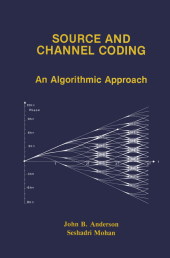 Neuerscheinungen 2012Stand: 2020-01-07 |
Schnellsuche
ISBN/Stichwort/Autor
|
Herderstraße 10
10625 Berlin
Tel.: 030 315 714 16
Fax 030 315 714 14
info@buchspektrum.de |

John B. Anderson, Seshadri Mohan
(Beteiligte)
Source and Channel Coding
An Algorithmic Approach
Softcover reprint of the original 1st ed. 1991. 2012. xiii, 433 S. XIII, 433 p. 235 mm
Verlag/Jahr: SPRINGER, BERLIN; SPRINGER US 2012
ISBN: 1-461-36787-5 (1461367875)
Neue ISBN: 978-1-461-36787-1 (9781461367871)
Preis und Lieferzeit: Bitte klicken
oW should coded communication be approached? Is it about prob H ability theorems and bounds, or about algorithms and structures? The traditional course in information theory and coding teaches these together in one course in which the Shannon theory, a probabilistic the ory of information, dominates. The theory´s predictions and bounds to performance are valuable to the coding engineer, but coding today is mostly about structures and algorithms and their size, speed and error performance. While coding has a theoretical basis, it has a practical side as well, an engineering side in which costs and benefits matter. It is safe to say that most of the recent advances in information theory and coding are in the engineering of coding. These thoughts motivate the present text book: A coded communication book based on methods and algorithms, with information theory in a necessary but supporting role. There has been muchrecent progress in coding, both inthe theory and the practice, and these pages report many new advances. Chapter 2 cov ers traditional source coding, but also the coding ofreal one-dimensional sources like speech and new techniques like vector quantization. Chapter 4 is a unified treatment of trellis codes, beginning with binary convolu tional codes and passing to the new trellis modulation codes.
1 Introduction.- 1.1 The Historical Context.- 1.2 Information and Coding.- 1.3 Bandwidth and Energy.- References.- 2 Source Coding Algorithms.- 2.1 Source Coding Preliminaries.- 2.2 Applications of Noiseless Source Coding.- 2.3 Rate-Distortion Theory.- 2.4 Predictive Source Coders.- 2.5 Some Other Rate-Distortion Approaches.- Problems.- References.- 3 Error Control Coding.- 3.1 Fundamentals of Coding.- 3.2 Linear Block Codes.- 3.3 Syndrome Decoding.- 3.4 Bounds on Performance.- 3.5 Cyclic Codes.- 3.6 Decoding Cyclic Codes.- 3.7 Algebra of Finite Fields.- 3.8 The BCH Codes.- 3.9 Decoding BCH Codes.- 3.10 Reed-Solomon Codes: Algebra in Non-Binary Fields.- 3.11 Codes for Burst Error Correction.- 3.12 Automatic Repeat Request Protocols.- Problems.- References.- 4 Trellis Codes.- 4.1 Convolutional Codes.- 4.2 Trees, Trellises and the Viterbi Algorithm.- 4.3 Continuous Phase Modulation Codes.- 4.4 Set-Partition Coding.- 4.5 Intersymbol Interference Decoding.- Problems.- References.- 5 Reduced Trellises.- 5.1 Truncation of the Impulse Response.- 5.2 Partition of the Path Map Alphabet.- 5.3 Pulse Response Simplification.- Problems.- References.- 6 Sequential Coding Algorithms.- 6.1 Basics of Sequential Coding.- 6.2 Important Channel Decoding Algorithms.- 6.3 Calculation of the Search Region Boundaries.- 6.4 Number of Paths Searched.- 6.5 Other Analyses of Sequential Decoding.- 6.6 Algorithm Steps.- 6.7 Source Coding Revisited.- Problems.- References.- 7 Architectures for Coding Algorithms.- 7.1 Parallel Architectures and Algorithms.- 7.2 Architectures for the M-Algorithm.- 7.3 Architectures for the Viterbi Algorithm.- Problems.- References.- APPENDICES.- A Signal Space Theory.- B Introduction to Algebra.- C Mathematical Details of the Stop and Drop Lines.


